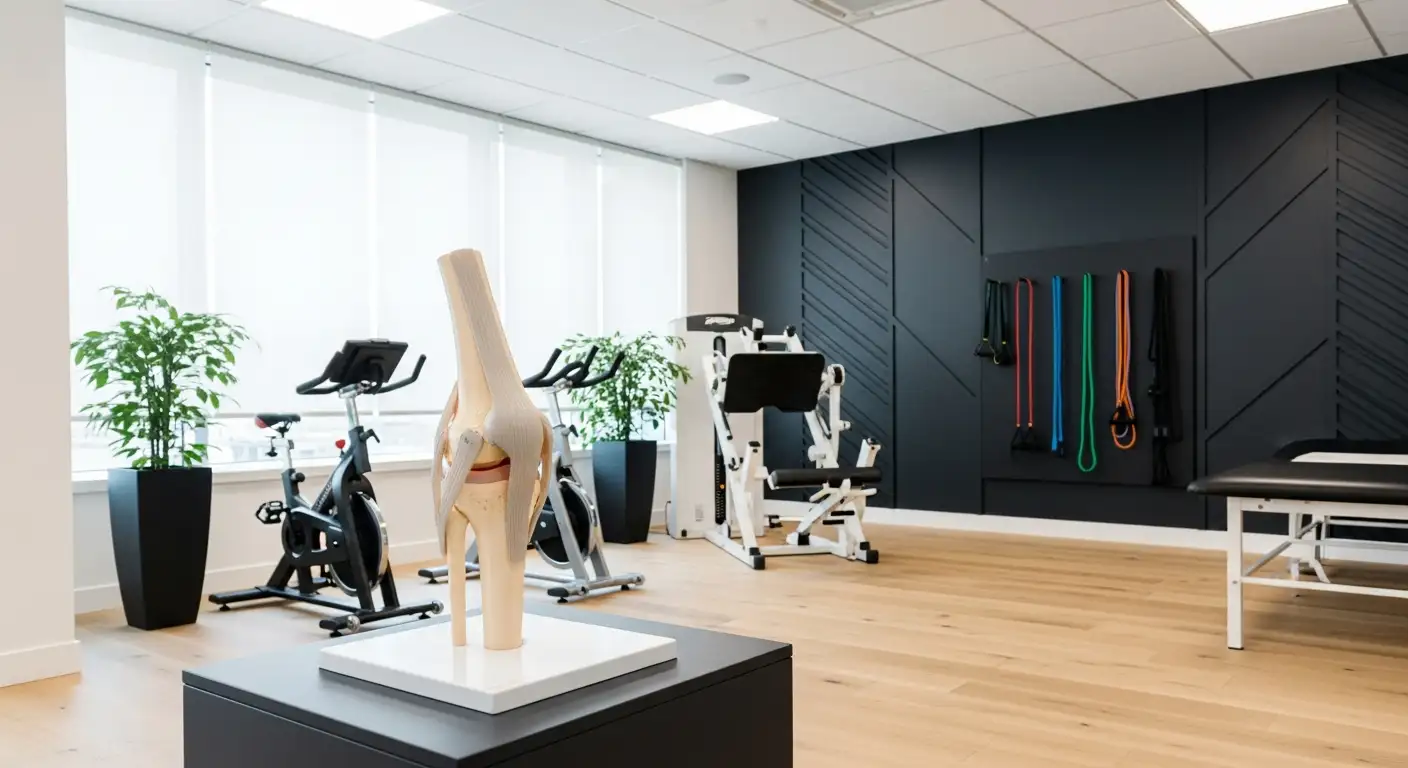Understanding Knee Pain
Knee discomfort is a common complaint that affects many individuals. Understanding the types and causes of knee pain can help identify potential treatments or management strategies.

Types of Knee Pain
There are several classifications of knee pain, including:
Understanding the type of pain is crucial for effective treatment. For further details, visit Healthline.
Causes of Knee Pain
Various factors contribute to knee pain, including:
CauseDescriptionSprains and StrainsDamage to ligaments and muscles around the knee from overuse or injury.TendonitisInflammation of tendons, often due to repetitive movements.Torn LigamentsInjuries to the knee ligaments can lead to instability and pain.Cartilage DamageDamage to the cartilage can result in osteoarthritis and pain during movement.Tight MusclesWeak or tight muscles, such as the hamstrings and quadriceps, can cause misalignment and pain [1].
Over-exercising, particularly with high-impact activities like running or doing squats, can aggravate knee pain. Adjusting workout routines to incorporate low-impact activities, such as swimming or cycling, is highly recommended.
Additionally, wearing improper footwear, such as non-supportive shoes or high heels, can exacerbate knee discomfort. Proper footwear or orthopedic inserts can help in distributing weight evenly [3].
It's vital to recognize that knee pain can stem from numerous conditions. Seeking guidance from a medical professional for proper diagnosis is essential, as some knee issues may require more than just at-home management.
Common Knee Conditions
Understanding common knee conditions can help individuals identify and manage pain in and around the knee joint. Here are three prevalent conditions that may lead to discomfort and mobility issues.
Knee Bursitis
Knee bursitis is a condition where one or more small fluid-filled sacs near the knee joint become inflamed. This inflammation results in significant pain and can limit movement. Symptoms often include swelling, tenderness, and discomfort with activity and pressure on the knee. Treatment typically involves self-care techniques, such as rest, ice, and elevation, as well as potential medical treatments depending on severity.
SymptomDescriptionPainDiscomfort around the knee jointSwellingVisible increase in sizeTendernessSensitivity to touchMovement LimitationReduced range of motion
Knee Swelling
Knee swelling is a common symptom that can arise from various factors, including sports injuries and health conditions like arthritis. Determining the underlying cause is essential, as treatment approaches may vary significantly. Some common causes of knee swelling include trauma, infection, and inflammatory conditions. Reducing swelling may involve rest, ice, compression, and medications [5].
CausePossible TreatmentTraumaRICE (Rest, Ice, Compression, Elevation)InfectionAntibiotics or drainage proceduresArthritisAnti-inflammatory medications
Patello-femoral Pain Syndrome
Patello-femoral pain syndrome is characterized by pain around the kneecap, often due to abnormal kneecap movement. This condition can result from muscle imbalances, tight muscles, and lower limb abnormalities. It leads to discomfort and, if left untreated, may cause cartilage wear behind the kneecap. Effective management typically includes physical therapy, exercises to strengthen the quadriceps and improve flexibility, and possibly the use of a knee wrap for pain [6].
FactorEffect on ConditionMuscle ImbalancesCan lead to improper kneecap trackingTight MusclesMay contribute to knee painLower Limb AbnormalitiesAffect knee alignment and function
Awareness of these common knee conditions can assist individuals experiencing discomfort in finding appropriate solutions. For further insights into what might be affecting their knee health, they may explore topics like can tight hamstrings cause knee pain or effective braces such as a knee hyperextension brace.
Factors Affecting Knee Pain
Knee pain can be influenced by various factors beyond specific injuries or conditions. Understanding these factors can assist individuals in mitigating discomfort and maintaining better knee health.
Impact of Weight on Knee
Excess weight significantly increases pressure on the knee joints, potentially exacerbating pain. Being overweight can lead to additional stress during daily activities, which may worsen existing pain or contribute to new issues. Research shows that even modest weight loss can alleviate knee pain and improve overall well-being.
Weight Loss (lbs)Expected Reduction in Knee Pressure (%)52010301540
Influence of Footwear
The type of shoes worn can dramatically affect knee pain. Non-supportive footwear, such as high heels or flat shoes, can alter the alignment of the body and increase stress on the knees. Shoes that lack cushioning or proper support may exacerbate existing conditions. Using cushioned or orthopedic inserts can help distribute weight more evenly and reduce joint stress [3].
Type of FootwearImpact on Knee PainHigh HeelsIncreases pressure and misalignmentFlat ShoesMay not provide adequate supportSupportive ShoesCan reduce stress on knees
Impact of Exercise Choices
Exercise plays a critical role in managing knee pain. Engaging in high-impact activities like running, jump training, or excessive squatting can aggravate knee discomfort. Conversely, a balanced exercise routine focused on low-impact activities such as walking, cycling, and swimming can help strengthen the knee without adding strain [2]. It's important to include both strengthening and stretching exercises in a routine, as they improve the function and movement of the knee joint. Problems above or below the knee, such as weak hip muscles, can also influence knee pain. Strengthening surrounding muscles may help alleviate discomfort [7].
Exercise TypeRecommended for Knee PainHigh-Impact (e.g., running)Not recommendedLow-Impact (e.g., cycling)Highly recommendedStrengthening ExercisesEssential for overall knee health
Understanding these factors can empower individuals to take proactive steps in addressing the pain they experience. For additional resources on managing knee discomfort and symptoms, consider exploring other topics such as can tight hamstrings cause knee pain or using a knee wrap for pain.
Managing Knee Pain at Home
Addressing discomfort in the knee joint can often be managed effectively at home with appropriate techniques and exercise. In this section, self-care strategies and the importance of exercise will be discussed.
Self-Care Techniques
When experiencing discomfort in the knee, implementing self-care techniques plays a pivotal role in alleviating pain. One key method is the "RICE" procedure, which includes Rest, Ice, Compression, and Elevation. This strategy can significantly reduce swelling and pain during flare-ups.
TechniqueDescriptionRestAvoid activities that aggravate knee pain.IceApply ice packs to reduce swelling, for 15-20 minutes every few hours.CompressionUse a knee wrap to provide support and help reduce swelling. Explore options such as knee wrap for pain.ElevationElevate the leg to help decrease swelling.
Additionally, incorporating daily stretching into the routine is essential in managing knee pain, particularly focusing on the vastus medialis stretch. Stretching helps maintain flexibility and prevent stiffness. Rolling out tight areas with a foam roller can help by engaging in myofascial release, which targets tension in the muscles that may be contributing to discomfort.
Weight management is also vital as being overweight can place extra stress on the knee joints. Even modest weight loss can lead to significant improvements in knee pain.
Importance of Exercise
Exercise stands as one of the most crucial components in managing knee pain effectively. Engaging in appropriate strengthening and stretching exercises can not only relieve pain but also enhance joint movement and overall function. Specifically, strengthening muscles around the hip can alleviate strain on the knee itself [7].
Low-impact exercises are generally recommended to minimize stress on the knees. Here are some beneficial exercises:
ExerciseBenefitsCyclingLow-impact aerobic exercise that builds strength.SwimmingProvides resistance without joint stress.Strength trainingStrengthens muscles supporting the knee.YogaEnhances flexibility and strength.
Adding flexibility exercises to the routine is essential to improve range of motion and reduce tension in tight muscles that surround the knee. If knee pain persists, exploring specific exercises for conditions like patellar tracking disorder may also be beneficial; additional insights can be gained from our article on 5 exercises to fix patellar tracking disorder.
Regular physical activity is key to maintaining healthy joints. By following these self-care techniques and engaging in consistent exercise, individuals can often find relief from discomfort and enhance their joint health.
Seeking Professional Help
Knee pain can often be managed at home with self-care techniques and exercises. However, there are instances when it is necessary to seek professional help. Understanding when to consult a doctor and knowing the available treatment options is essential for anyone experiencing the inside of their knee pain.
When to See a Doctor
Individuals should consider seeing a doctor if they experience any of the following symptoms:
These symptoms may indicate a more serious condition, such as a torn ligament or cartilage damage, which requires medical intervention.
Treatment Options
The treatment for knee pain varies significantly based on the cause of the discomfort. Here is an overview of potential treatment options:
Treatment OptionDescriptionRest and IceInitial treatment includes resting the knee and applying ice to reduce swelling.Physical TherapyGuided rehabilitation programs help strengthen muscles around the knee and improve mobility [5].MedicationsOver-the-counter pain medications like NSAIDs or acetaminophen may help manage pain and inflammation.BracingUsing a knee hyperextension brace or a quadriceps tendonitis brace can provide additional support.InjectionsCorticosteroid injections may be used for severe inflammation.SurgeryIn cases of severe injury like torn ligaments or meniscus, surgical options such as knee arthroscopy may be necessary [5]. Knee replacement surgery might be an option for patients with advanced arthritis symptoms.
When knee pain and swelling persist, it is vital to follow up with a healthcare provider for a thorough evaluation and tailored treatment plan. Professional help ensures proper diagnosis and can significantly enhance recovery and long-term knee health. For additional approaches, consider exploring exercises and products designed to alleviate knee pain, such as knee wraps for pain, and educational resources like the vastus medialis stretch.
Preventing Knee Pain
Preventing knee pain requires attention to both exercise and lifestyle choices. By making strategic adjustments, individuals can alleviate strain on their knees and promote overall joint health.
Exercises for Knee Health
Engaging in specific exercises can significantly improve knee health. It is essential to strengthen the muscles surrounding the knee joint, including the quadriceps, hamstrings, and hip muscles. Effective exercises help improve joint movement and alleviate pain.
ExerciseTargeted MusclesFrequencySide-leg raiseHip abductorsAt least 2 days a weekSingle-leg liftHamstrings, quadricepsAt least 2 days a weekWalkingOverall leg musclesDaily or as toleratedSwimming and water aerobicsAll major muscle groups3-4 times a week
Incorporating these exercises can support knee alignment and stability. For more information on suitable stretches, check out our guide on vastus medialis stretch. Regular activity benefits not only the knees but also overall health.
Lifestyle Changes to Prevent Knee Pain
Several lifestyle choices can impact knee pain. Here are some modifications to consider:
Adopting these exercises and lifestyle changes can effectively reduce the risk of experiencing knee pain, ensuring better mobility and a more active life.
References
[2]:
[3]:
[4]:
[5]:
[6]:
[7]:




